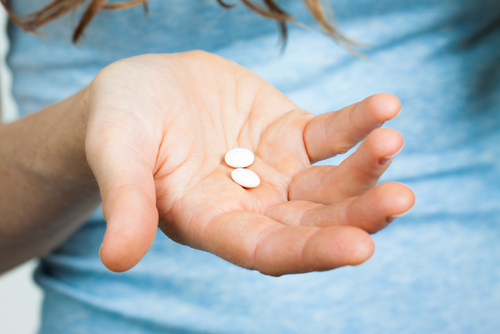Daily low oral doses of naltrexone — a medicine normally used to treat opioid or alcohol addiction — may relieve tenderness, fatigue, and pain in people with fibromyalgia, a pilot dose-response study has found.
A daily dose of 4.5 mg seems to be a good choice for lessening such fibromyalgia symptoms, although researchers state that more robust studies — larger, randomized, placebo-controlled trials — are needed to define the optimal treatment regimen and benefits of naltrexone.
These findings were reported in the study, “Low-Dose Naltrexone for the Treatment of Fibromyalgia: Investigation of Dose–Response Relationships,” published in the journal Pain Medicine.
There is no cure for fibromyalgia, a disorder characterized by widespread musculoskeletal pain, and fatigue, sleep, memory, and mood issues. Medications commonly used to treat the disorder usually focus either on blocking the activity of certain messenger molecules — called neurotransmitters — involved in the excessive transmission of nerve signals in the brain, or prolonging the effects of messengers that offset those signals.
Oral naltrexone, marketed as Revia and Vivitrol, and also available as generics, is an add-on treatment for opioid or alcohol dependence. It also has been used off-label for the treatment of other conditions, including impulse control disorders, and chronic pain conditions such as fibromyalgia.
Low doses of naltrexone can have pain-relieving and anti-inflammatory effects in the nervous system. Given these effects, the medicine has been thought to be beneficial in treating chronic pain and inflammatory disorders, including Crohn’s disease, multiple sclerosis, and fibromyalgia. However, while low doses of naltrexone have been shown to reduce symptom severity in patients with such conditions, its use is still experimental.
Only three small clinical studies have investigated naltrexone’s benefits in fibromyalgia: a pilot, single-blind, crossover trial enrolling 10 women; a randomized, double-blind study enrolling 31 women (NCT00568555); and a post-hoc analysis assessing the medicine’s effects on symptoms perceived by patients with different disorders and establishing correlations with markers of inflammation.
In both trials to date, naltrexone was found to significantly reduce pain associated with fibromyalgia in 57-60% of patients, compared with a placebo. The participants were treated for eight to 12 weeks, a daily dose of 4.5 mg.
Half of the patients reported their symptoms “much improved” or “very much improved” after taking the medication. An additional study also concluded that an eight-week treatment regimen with 4.5 mg of daily naltrexone lowered the levels of pro-inflammatory markers in the blood of women with fibromyalgia.
However, no dose-response studies have been carried out to define the optimal dose of naltrexone for treating the disease — an issue that has now been addressed by researchers in Denmark.
“Choosing a relevant test dose is crucial, as a test dose that is too low might lead to low response rates and a test dose that is too high might lead to high dropout rates because of side effects,” the researchers said.
The new study (2016–002081-31) enrolled 25 women with fibromyalgia, ages 27–59, who had been referred to the Odense University Hospital, in Denmark, and treated with one of eight daily doses of naltrexone for three weeks. The doses ranged from 0.75 mg to 6 mg. All participants were blinded to which specific dose of naltrexone they received.
Among the 25 participants, 11 — nearly half — responded well to naltrexone, reporting at least a 30% reduction in their pain levels compared with the start of the treatment (baseline), or significant symptom relief after two weeks of therapy.
Using the dose-response data obtained, the researchers estimated that the daily dose of naltrexone that seemed to be effective in 50% of the patients (ED50) was 3.88 mg. Meanwhile, the daily dose that was effective in 95% of the patients (ED95) was 5.40 mg.
“Based on our findings in this study, a dose of 4.5 mg seems to be a reasonable test dose in FM [fibromyalgia] patients, as it lies in the range between our estimates of ED50 and ED95,” the researchers said.
“Tenderness” and “waking unrefreshed” were the two symptoms most relieved by naltrexone, although patient responses varied considerably. That was the main finding of a secondary analysis assessing the treatment’s effects on the 10 most common symptoms of fibromyalgia. Perceived tenderness continued to decrease after the third week of treatment, the results showed.
Four of the 11 patients who responded to treatment reported pain reduction greater than 30% two weeks after starting naltrexone, but this positive effect faded in the third week, the results showed.
“Future placebo-controlled randomized clinical trials are needed, and according to our findings, 4.5 mg, which has previously been used, seems to be a relevant test dose,” the researchers said. “We recommend that future studies include additional nonpain fibromyalgia symptoms as outcome measures.”
A larger, ongoing Phase 2 study called FINAL (NCT04270877) is evaluating the effects of low-dose naltrexone on pain in women with fibromyalgia. The study expects to enroll 100 participants and is currently recruiting at the Odense University Hospital. More information about the trial is available here.

